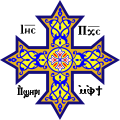Population and distribution
According to the 2011 census, there were 3,570 Canadians who reported Coptic ancestry (this figure combines single and multiple ethnic origin responses). Of this number, 755 Canadians reported Coptic as their only ancestry, whereas 2,810 reported Coptic as one of multiple ancestries. [4]
In the same survey, around 17,000 Canadians said they belonged to the Coptic Orthodox Church. Of this number, 12,645 were immigrants and 3,365 were born in Canada. [1]
The Canadian Coptic Association estimates that there are 35,000 Copts living in Canada; according to CBC News, "if other sects with strong ties to the Coptic community are included, the figure is possibly higher still." [5] (Note: There is likely a typo in the CBC article where an extra zero was added, thereby erroneous stating that there are 350,000 Copts in Canada).
Toronto and the surrounding metropolitan region have the largest concentration of Copts in Canada. [5]
Coptic Orthodox Church in Canada
In 1964, St. Mark Coptic Orthodox Church was established in Toronto; this was the first Coptic church established in the Coptic diaspora. [6]
In 2002, a survey showed 22 Coptic Orthodox parishes in Canada, indicating growth. [7]
In 2011, there were five Coptic Orthodox churches in Montreal. [8]
This page is based on this
Wikipedia article Text is available under the
CC BY-SA 4.0 license; additional terms may apply.
Images, videos and audio are available under their respective licenses.


